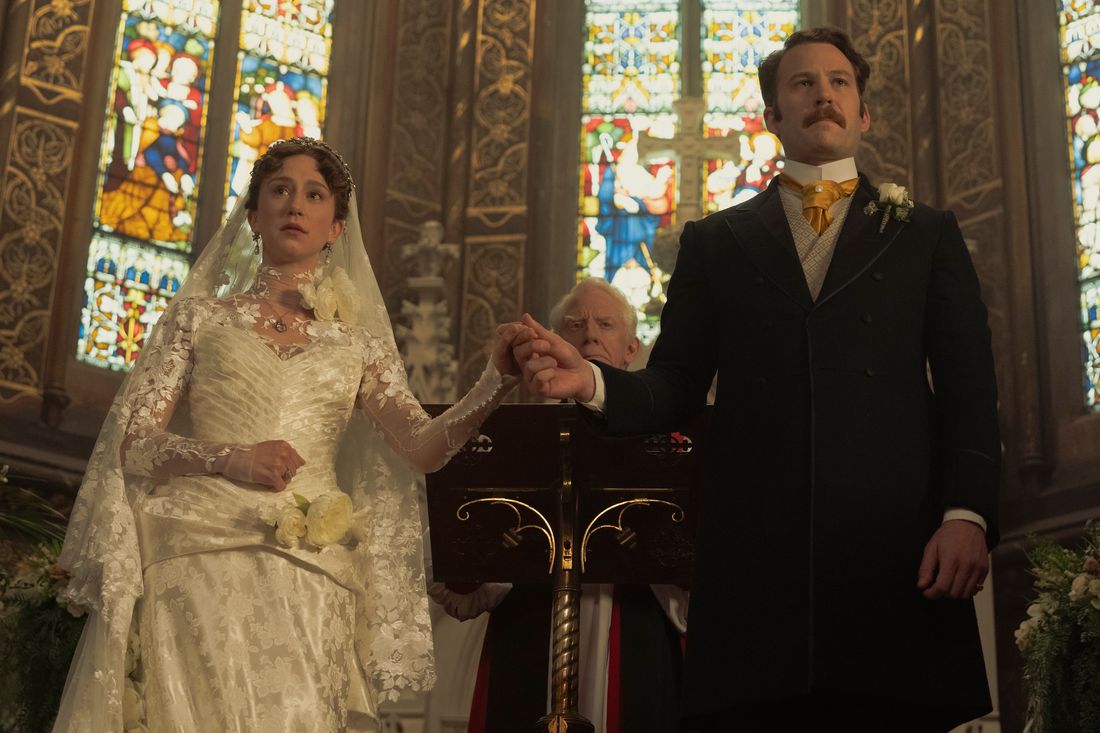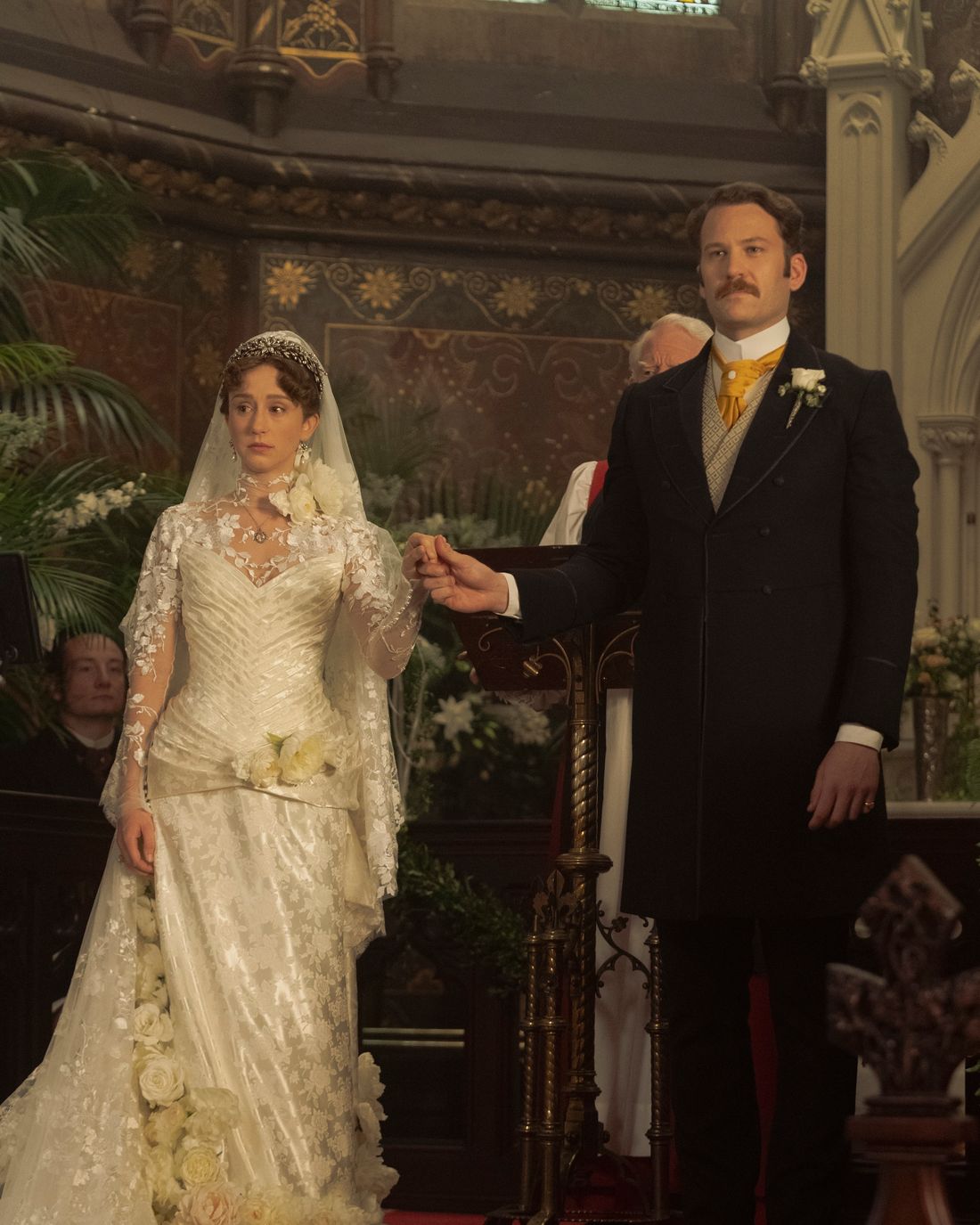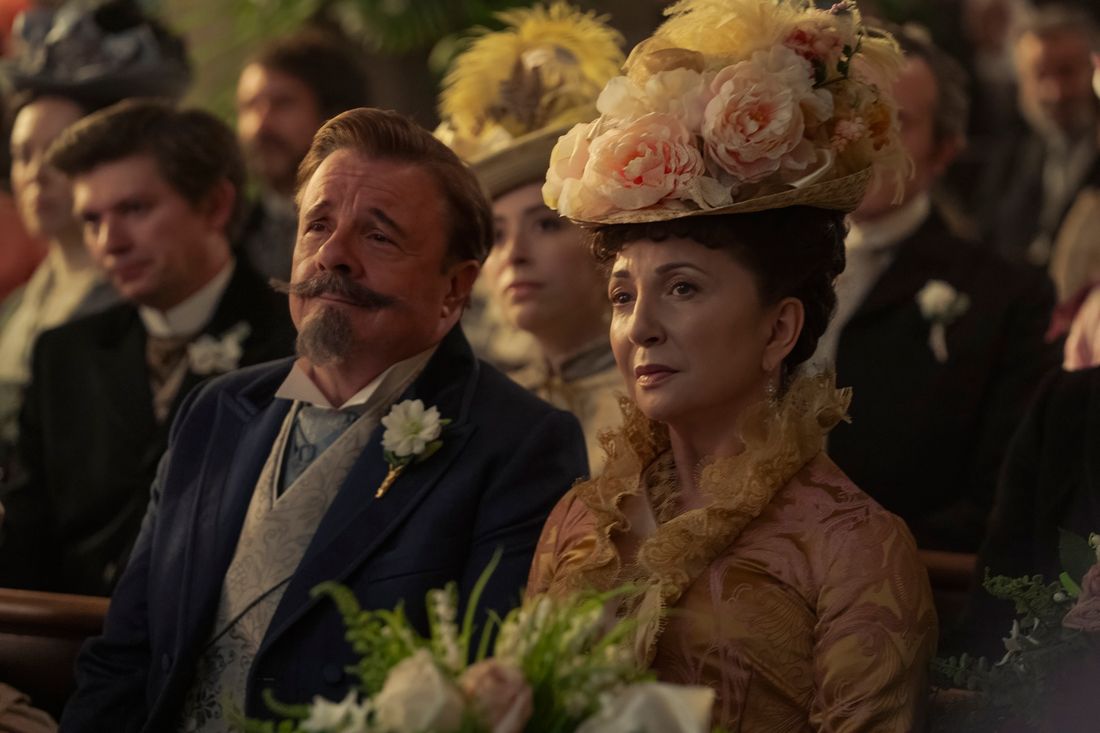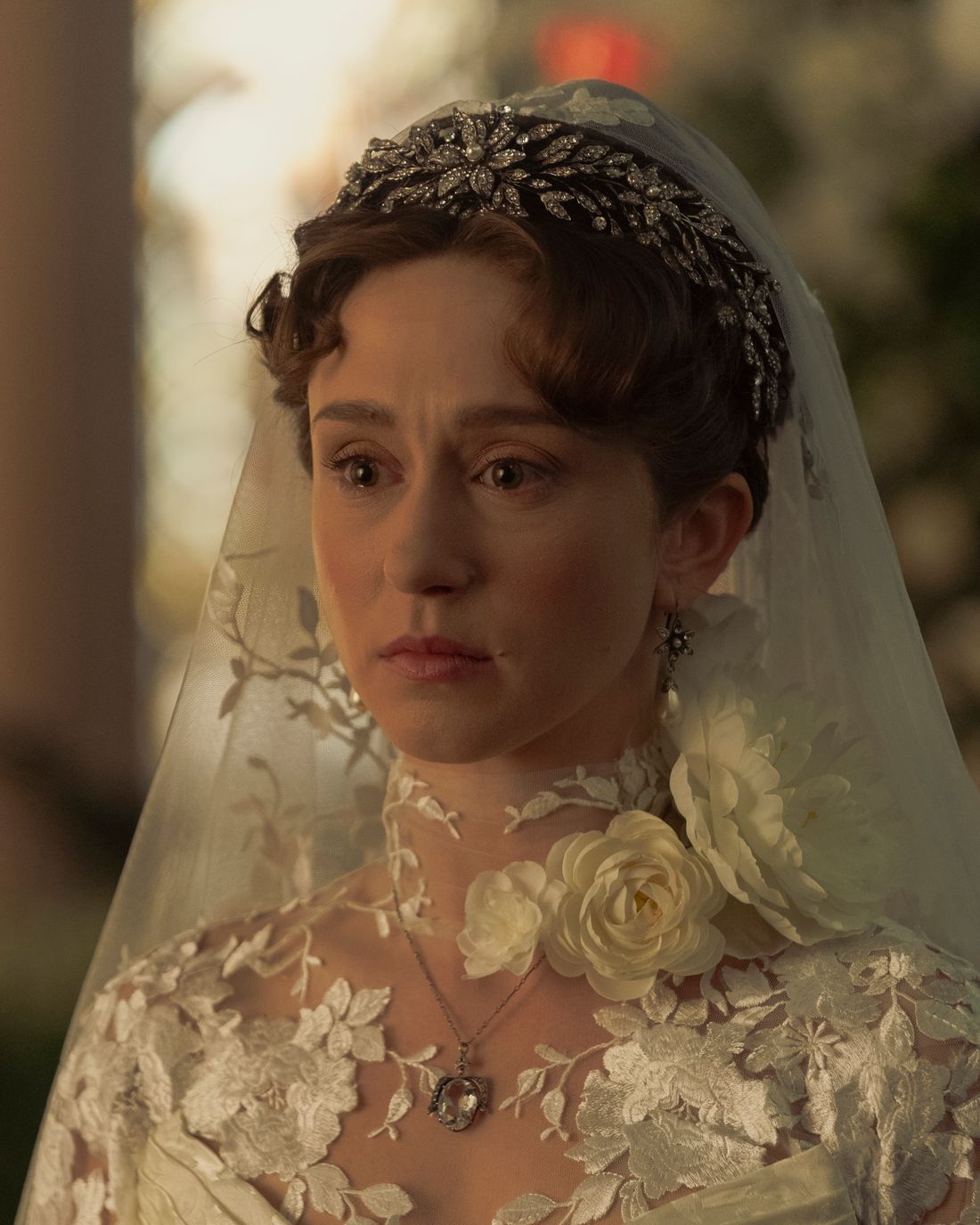
In the TV series ‘The Gilded Age’, Carrie Coon portrays Bertha Russell, a determined social climber who has spent three seasons fighting for her family’s status in high society. Initially, she battled to secure their position within it, and later, to claim the top spot. Her teenage daughter Gladys (Taissa Farmiga) becomes her most effective weapon. During season one, Bertha skillfully used Gladys’ friendship with Carrie Astor to encourage New York’s elite families to visit the Russell’s upscale residence. In the recent episode “Marriage Is a Gamble”, Bertha finally manages to marry off Gladys to the Duke of Buckingham, which not only grants her a title but also places her in the English peerage, making even the most established American families seem newly wealthy in comparison. As Mrs. Astor remarks while attending the wedding, “What an achievement for Mrs. Russell. It’s remarkable when you consider that just three years ago, none of us had heard of her.
Despite the somber mood experienced by most members of the Russell family, the wedding is a grand spectacle that cannot be ignored. George (Morgan Spector) walks his daughter down the aisle with a somber expression, the bridesmaids carrying her veil in groups of three evoke an undertaker’s procession, and Gladys seems more like a ghost than a bride. Yet, the sorrowful wife’s tears cannot overshadow the lavishness of the ceremony, which was not an exact replica but was inspired by one of the most extravagant weddings from the real Gilded Age. Director Michael Engler wonders, “How were we going to pull off what truly was the Wedding of the Century?” Here’s the answer to that question.
The History
In the grand cast of “The Gilded Age,” several characters are based on real historical figures, such as Mrs. Astor (Donna Murphy), Ward McAllister (Nathan Lane), and Mamie Fish (Ashlie Atkinson). The Russells, however, are purely fictional but share similarities with notable Gilded Age families, particularly the Vanderbilts. The plot of Gladys is loosely inspired by the life of Consuelo Vanderbilt, a socialite who became one of the renowned “dollar princesses,” American heiresses who married into British nobility. This transatlantic marriage allowed American aristocracy to establish themselves in English society, while the ailing noble houses gained access to fresh American industrial wealth.
In 1895, Consuelo’s marriage to the Duke of Marlborough was widely known and unfortunately infamous, as she had desired to wed Winthrop Rutherford instead (represented in ‘The Gilded Age’ as Billy Carlton). The wedding of Consuelo drew significant public interest, as Bob Shaw, a production designer, explains. “There were crowds outside the church and outside their home that would only resemble the scene for Beyoncé today,” he says. “They required a police presence at their residence because the crowds attempted to rush into the church.” The Vanderbilts were resolute that no one catch a glimpse of Consuelo’s wedding dress before the ceremony, leading them to construct a white tent between their front door and the carriage transporting her to the church. “We initially intended to do it but changed our minds in the end,” says Shaw. “It was something that required too much explanation. It seemed like what they put in front of the house when they went to catch E.T.
The details of Consuelo’s wedding were extensively recorded, providing a wealth of resources such as written descriptions, artwork, photos, and precise measurements for production. As Shaw explains, “They would devote a significant amount of space to describing the flowers, the bride’s attire.” This allowed them to adapt the portrayal of the wedding in the show for historical accuracy (since Gladys’s wedding is set a decade before Consuelo’s) and to meet the unique requirements of the characters.
A significant portion of the episode focuses on Gladys, who insists on remaining in her room, delaying events as much as she can. The narrative tension escalates until she utters “I will” at the altar, her eyes red from crying. The delayed arrival and teary-eyed bride are based on real events, but other aspects of the story are even more poignant in reality. In actuality, Consuelo was confined to her room by her mother, Alva, but the creators of “The Gilded Age” opted to give Gladys more autonomy. As Engler explains, instead of portraying her as a mere victim of societal norms, they wanted to show that she had choices to make about how she wished to live and what she was willing to sacrifice. The episode illustrates the ways these young women were treated as commodities by their families, but it also highlights Gladys’ involvement in the negotiation process. According to Engler, it’s not a matter of whether or not she will get married; it’s about how she navigates that journey.
Fellowes acknowledges benefits in the role of the ‘dollar princess.’ During that era, American education for women differed significantly from European girls who were discouraged from expressing opinions or introducing new topics, especially political ones. Englishmen, particularly the Prince of Wales, admired these American women because they engaged in debates and displayed a spirited nature during dinner conversations. An unmarried English lady was typically expected to remain quiet and demure until she was proposed to.
The Dress

Costume designer Kasia Walicka-Maimone expresses her enthusiasm when she hears the word ‘wedding.’ The initial phase of their work kicked off with the script analysis: “How does this plot progression align with our character’s storyline?” Given it was a day wedding, more body coverage was needed compared to an evening wedding, which helped convey Gladys’s subdued emotional state, as Walicka-Maimone explains, “this reserved, guarded appearance, rather than the usual bridal joy.” Following this, they delve into historical research. Consuelo Vanderbilt’s wedding served as a significant inspiration; however, Walicka-Maimone acknowledges the gap between reality and fiction: “There is always a difference between what truly occurred and what takes place in our narrative.” For instance, the extravagant train was inspired by the actual length of Consuelo’s train – Walicka-Maimone mentions it might have been 60 feet or something extraordinary – but they calculated its width based on the church’s center aisle, taking into account the large flower arrangements on either side.
In creating the bridesmaids’ attire, the costume team drew inspiration from Consuelo’s wedding photographs, depicting an ensemble of ladies adorned with hats, gowns, and high necklines. However, the design of Gladys’s wedding dress was to remain authentic to the era, and for this, they turned to paintings from the 1880s for guidance on shaping and styling the dress appropriately for the Gilded Age.
Walicka-Maimone and her team often opt for fabrics true to the era, such as the wedding dress needing a complex blend of laces, silk, and flowers. However, their primary concern was ensuring it appeared authentic on screen. She explains, “At times I sacrificed fiber accuracy because my responsibility is to provide the most cinematic portrayal of what the impression would have been.” The dress’s construction details like draping and pleats were handled with a silicon-poly fiber to ensure durability during several days of rehearsals and filming. On screen, it appears silkier and whiter than real silk. “For cinematic purposes, I required more sheen than real silk could provide. We examined numerous fabric samples for the dress, and the plan was to photograph the material and determine what would show best for texture, sheen, and whiteness.” The exact shade of white was also a significant concern: “Pure white would be too bright, while cream white would dull it.” They eventually chose a slightly off-white hue that wasn’t overly pale and wouldn’t become creamy.
Walicka-Maimone estimates that designing the dress took more than a month, followed by at least six weeks for its construction. In both America and Europe, approximately 200 people – in-house designers, external craftspeople like milliners – collaborated on the wedding costumes, encompassing the principal guests, groom, bridesmaids, and background artists. The costume team initially developed a color scheme for the wedding, resulting in multiple weeks of fittings with their fitting teams. They also looked through past seasons to identify reusable outfits. Although some costumes from a previous Easter episode were modified, most of what we see during the wedding is entirely new.
In specific instances, it made narrative sense to reuse a dress, such as Monica’s (played by Merritt Wever) attire in the story. Since we know that in the plot, she rummages through Bertha’s closet and selects something for alteration, the costume department opted for a dress that Bertha wore in Newport during season one. This dress was particularly busy up front, as it was initially designed to conceal Coon’s pregnancy at the time. It also had a more traditional style compared to other dresses in Bertha’s closet. According to Walicka-Maimone, this gown fit logically with Monica’s character wearing it at the wedding.
Approximately 60 to 70 individuals from the wardrobe team were present during filming; they’d typically begin dressing the background actors around 3 a.m., ensuring proper fit of corsets, layers, hats, and accessories, working closely with the hair and makeup department, and arranging flowers on Gladys’s train. Farmiga mentions that the wedding dress was extremely heavy and voluminous, making it difficult for her to move between takes. “I had to remain still,” she said. “They essentially confined me, which aided my performance as I felt confined, and Gladys felt confined. This provided something for me to draw upon.
The Church
Consuelo’s wedding ceremony took place at St. Peter’s Church in Albany, a stunning Gothic Revival-style Episcopal church designed by the same architect as St. Thomas Church on Fifth Avenue. This church replaced the Vanderbilt’s chateau that was destroyed in 1905. Production designer Bob Shaw was tasked with decorating it to match the grandeur of the Russell family, as depicted in the series “The Gilded Age”. Shaw found the marble mosaic floors too beautiful to cover, so they opted to decorate around them instead. The wedding needed a spacious location that could convey the extravagant opulence typical of families like the Russells. As Fellowes puts it, “There was no humility, no modesty. They were at the top and wanted everyone to know it.” This demanded…
The Flowers
As a fan, I’d rephrase it as: Shaw points out that if anything, Gladys’s wedding was more modest than Consuelo’s. He notes, “They seemed to be always trying to impress people with things only the affluent could acquire.” This is evident in their choice of out-of-season flowers and even the exotic palm trees adorning the altar, which was quite unexpected upon closer examination.
Despite its abundance often overpowering its scarcity, this show has a tendency to feature an overwhelming amount of items, particularly within the characters’ homes. For instance, Shaw mentioned that the excessive number of flower arrangements could sometimes appear chaotic and might not align with contemporary standards of taste or beauty. This practice of restraint is surprisingly frequent on the show. Furthermore, he noted that the numerous pieces of artwork in a single house could be visually distracting.
The initial step in his wedding design was capturing images of St. Peter’s Basilica from behind and enhancing them on his iPad using Procreate. Subsequently, he presented these designs to the set decorator and florist Tess Casey during season three, who decided which flowers could be genuine and which needed to be artificial. In most cases, The Gilded Age prefers real flowers, but due to the grand scale of this scene and the extended multi-day shoot, a higher proportion of flowers had to be artificially made.
Initially, artificial blooms filled the set, later on during filming, actual flowers were incorporated. “I can’t specify an exact number of how many thousands of flowers,” shares Shaw. While Engler filmed various scenes, the team had to keep a watchful eye and be prepared to adjust quickly. “If we focused on Mamie Fish and noticed an artificial flower in the shot, someone would rush to swap it with a real one because we aimed to use genuine flowers close to the camera,” Shaw explains. Many of these flowers were displayed on large arches measuring 8 feet by 12 feet that stretched across the main aisle, sourced by Casey. To maintain historical authenticity, most of the flowers were roses and carnations, predominantly white. “We may consider carnations as ordinary today, but they were quite popular back then,” Shaw notes.
Initially, there were intended to be more floral decorations than what eventually appeared on-screen. These large garlands of flowers were meant to stretch from one aisle to another; however, they interfered with a crucial overhead crane shot and had to be taken out. A suitable number of palm trees at the altar were allowed to remain.
The Guests

At the Russell wedding, notable personalities such as Agnes Van Rhijn (Christine Baranski) and Ada Forte (Cynthia Nixon), along with returning talents like Kelley Curran (Mrs. Turner) and Nathan Lane’s Ward McAllister, are among the attendees. These actors had brief moments to shine as their characters interacted before the wedding, but a significant portion of filming involved them sitting or standing in pews for crowd shots. As Engler explains, “We aim to function efficiently as a production, maximizing the value of having such busy individuals join us, essentially playing extras, seated in that warm Albany church for three days, during which you might catch a glimpse of her hat from afar or his mustache. We strive to arrange it in a way that causes the least discomfort for everyone.” On the positive side, “Since these individuals are familiar with each other but rarely get to interact, they had ample time in trailers chatting, as they were used as extras for a couple of days. They all seemed cheerful to be there.
The Walk

In my account, I shared that we reenacted Gladys’s walk down the aisle about twenty times, with her genuinely sobbing in most instances. However, in about seventeen and a half of those takes, she displayed a unique blend of emotions subtly differently. Engler, describing the climax of the episode, emphasized this emotional and aesthetic peak as Gladys’s walk down the aisle. He further explained that the director aimed to ensure the story was portrayed authentically.
Initially, we started with highly emotive scenes where Gladys was visibly distraught during her walk down the aisle. Then, Michael suggested we try more restrained takes. At that point in time, it was expected that one should conceal emotions, even during rebellion. As an 18-year-old, Gladys was defying conventions by saying, “Fuck this shit,” but she still needed to adhere to the etiquette rules of the era. One of those less expressive takes eventually made it to the final cut.
Farmiga shares, “Throughout my career, I’ve tackled plenty of horrifying roles, and it’s always thrilling due to the over-the-top elements. This season was quite chilling for Gladys, as she was compelled into a marriage she didn’t cherish. It was entertaining to portray these intensified emotions.” She explains, “I ensure I drink plenty of water, as you might be amazed how rapidly tears can deplete. I learned that trick years ago, while working on the American Horror Story set.
As Gladys makes her way down the aisle, the camera switches to her viewpoint, capturing through her veil the guests fixated on her. Engler intentionally included this scene to intensify Gladys’s feeling of disorientation. To accomplish this, Walicka-Maimone crafted a second, shorter version of Gladys’s veil that was identical to the original. This trick was employed because the camera didn’t require capturing all the lengthy train following Gladys.
In terms of creative execution, writers and executive producers Fellowes and Sonja Warfield opted against providing instructional guidance in the script. Engler’s directorial touches were uniquely his own, as was Walicka-Maimone’s costume design, Shaw’s production design, and Farmiga’s acting decisions. As Warfield puts it, “We’re all artists, and the last thing you want to do is dictate to another artist.
During the vows, there’s a tense silence before Gladys utters “I will.” This moment represents her last-ditch effort, the fleeting seconds just before she verbally agrees to the future she had spent the entire season trying to evade. As Farmiga explains, “We replayed it numerous times. There were extended pauses, but fundamentally, it conveyed What on earth am I doing? And she knew that she had no other choice.” From the audience’s perspective, the pause is more a question of “Will she or won’t she?” However, Gladys likely understood that she was going to say yes.
Read More
- Who Is Harley Wallace? The Heartbreaking Truth Behind Bring Her Back’s Dedication
- 50 Ankle Break & Score Sound ID Codes for Basketball Zero
- Lost Sword Tier List & Reroll Guide [RELEASE]
- 100 Most-Watched TV Series of 2024-25 Across Streaming, Broadcast and Cable: ‘Squid Game’ Leads This Season’s Rankers
- 50 Goal Sound ID Codes for Blue Lock Rivals
- KPop Demon Hunters: Real Ages Revealed?!
- The best Easter eggs in Jurassic World Rebirth, including callbacks to Jurassic Park
- Umamusume: Pretty Derby Support Card Tier List [Release]
- Basketball Zero Boombox & Music ID Codes – Roblox
- Come and See
2025-07-14 05:55